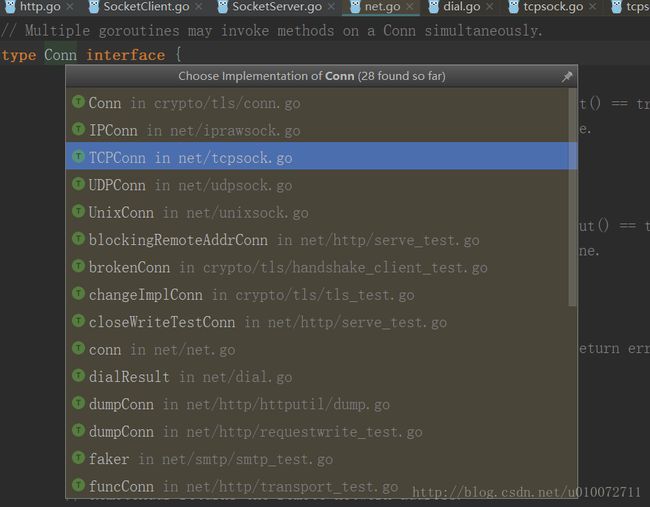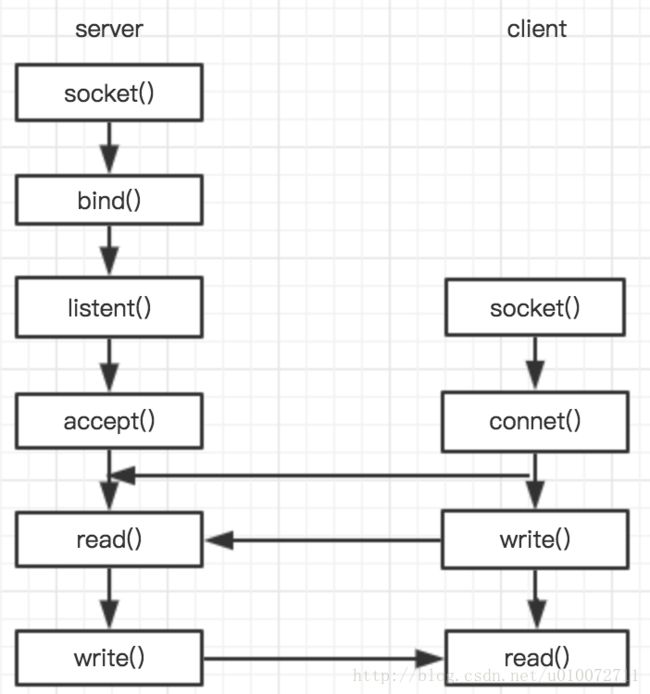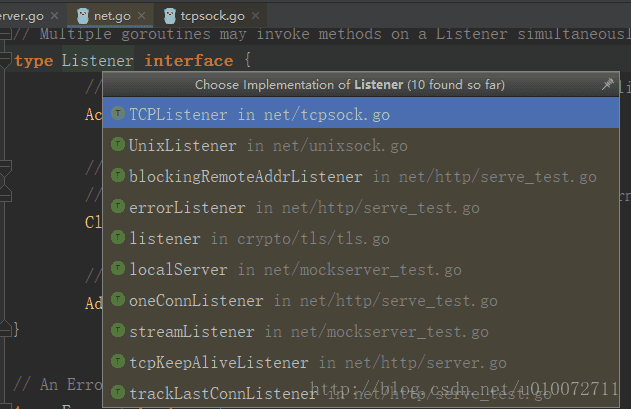golang笔记(2)写一个简单的socket服务端
windows开发环境搭建http://blog.csdn.net/u010072711/article/details/72859731
一、概述
1.socket解读
2.socket与HTTP关系
3.socket与TCP/UDP关系
4.HTTP与TCP/UDP关系
二、第一步:绑定端口
//创建socket文件描述符,绑定ip:port,改变socket状态为监听状态
netListen, err := net.Listen("tcp", "192.168.123.27:9800")
//defer延迟关闭(方法返回的时候关闭)资源,以免引起内存泄漏
defer netListen.Close()这里的net.Listen方法为net包dial.go类中的一个方法。
第一个参数是制定网络IO类型,比如有TCP/IP, UDP, 域名解析, Unix domain socket
第二个参数是host:port 就是ip和端口号的组合。
第一个返回的的是当前连接socket状态监听器。
第二个返回是错误,我们可以判断,如果错误不为空就返回。
第一个返回的netListen是net.go类中的一个接口:
// A Listener is a generic network listener for stream-oriented protocols.
//
// Multiple goroutines may invoke methods on a Listener simultaneously.
type Listener interface {
// Accept waits for and returns the next connection to the listener.
//从socket recive队列里获取一个建立好的连接
Accept() (Conn, error)
// Close closes the listener.
//关闭监听器
// Any blocked Accept operations will be unblocked and return errors.
Close() error
// Addr returns the listener's network address.
//返回链接的传输类型和ip地址
Addr() Addr
}这个接口里的三个方法实现了对打开socket的三种基本操作,并在很多类中实现了这个接口,具体请看:
不同的具体链接都会实现这个接口,方便我们对socket链接做基本操作。
三、第二步:建立连接
conn, err := netListen.Accept() //第二步:获取连接第一个返回 conn是当前socket链接。
第二个返回是错误,我们可以判断,如果错误不为空就返回。
第一个返回conn也是net.go类中的一个接口,源代码如下:
// Conn is a generic stream-oriented network connection.
//
// Multiple goroutines may invoke methods on a Conn simultaneously.
type Conn interface {
// Read reads data from the connection.
// Read can be made to time out and return an Error with Timeout() == true
// after a fixed time limit; see SetDeadline and SetReadDeadline.
Read(b []byte) (n int, err error)
// Write writes data to the connection.
// Write can be made to time out and return an Error with Timeout() == true
// after a fixed time limit; see SetDeadline and SetWriteDeadline.
Write(b []byte) (n int, err error)
// Close closes the connection.
// Any blocked Read or Write operations will be unblocked and return errors.
Close() error
// LocalAddr returns the local network address.
LocalAddr() Addr
// RemoteAddr returns the remote network address.
RemoteAddr() Addr
// SetDeadline sets the read and write deadlines associated
// with the connection. It is equivalent to calling both
// SetReadDeadline and SetWriteDeadline.
//
// A deadline is an absolute time after which I/O operations
// fail with a timeout (see type Error) instead of
// blocking. The deadline applies to all future and pending
// I/O, not just the immediately following call to Read or
// Write. After a deadline has been exceeded, the connection
// can be refreshed by setting a deadline in the future.
//
// An idle timeout can be implemented by repeatedly extending
// the deadline after successful Read or Write calls.
//
// A zero value for t means I/O operations will not time out.
SetDeadline(t time.Time) error
// SetReadDeadline sets the deadline for future Read calls
// and any currently-blocked Read call.
// A zero value for t means Read will not time out.
SetReadDeadline(t time.Time) error
// SetWriteDeadline sets the deadline for future Write calls
// and any currently-blocked Write call.
// Even if write times out, it may return n > 0, indicating that
// some of the data was successfully written.
// A zero value for t means Write will not time out.
SetWriteDeadline(t time.Time) error
}我们可以看到里面有一系列的读写和关闭操作,就如上面说到的Listener 接口,也肯定是在很多具体的socket连接中被实现了,验证如下:

我们这里用的肯定是TCPConn了。
四、第三步:读写数据
上面我们也看到了,既然我们用的是TCPConn,也就是基于TCP的Socket链接。
里面的读写操作都已经实现了,我们直接调用就行了。
下面是socket服务端和客户端的交互过程:

其实里面的不管是客户端还是服务端,只要socket长链接建立成功了,我们读写都随便的,可先可后,具体看你的业务需求。
我们使用一个无限for循环来不断读写:
buffer := make([]byte, 2048)
for { //无限循环
n, err := conn.Read(buffer) //第三步:读取从该端口传来的内容
//words := "ok" //向链接中写数据,向链接既可以先读也可以先写,看自己的需要
words := "golang socket server : " + strconv.Itoa(rand.Intn(100)) //向链接中写数据
conn.Write([]byte(words))
if err != nil {
Log(conn.RemoteAddr().String(), " connection error: ", err)
return //出错后返回
}
Log(conn.RemoteAddr().String(), "receive data string:\n", string(buffer[:n]))
}五、服务端完整代码
package main
import (
"fmt"
"net"
"log"
"os"
"math/rand"
"strconv"
)
func main() {
//建立socket,监听端口 第一步:绑定端口
//netListen, err := net.Listen("tcp", "localhost:1024")
netListen, err := net.Listen("tcp", "192.168.123.27:9800")
CheckError(err)
//defer延迟关闭改资源,以免引起内存泄漏
defer netListen.Close()
Log("Waiting for clients")
for {
conn, err := netListen.Accept() //第二步:获取连接
if err != nil {
continue //出错退出当前一次循环
}
Log(conn.RemoteAddr().String(), " tcp connect success")
//handleConnection(conn) //正常连接就处理
//这句代码的前面加上一个 go,就可以让服务器并发处理不同的Client发来的请求
go handleConnection(conn) //使用goroutine来处理用户的请求
}
}
//处理连接
func handleConnection(conn net.Conn) {
buffer := make([]byte, 2048)
for { //无限循环
n, err := conn.Read(buffer) //第三步:读取从该端口传来的内容
//words := "ok" //向链接中写数据,向链接既可以先读也可以先写,看自己的需要
words := "golang socket server : " + strconv.Itoa(rand.Intn(100)) //向链接中写数据
conn.Write([]byte(words))
if err != nil {
Log(conn.RemoteAddr().String(), " connection error: ", err)
return //出错后返回
}
Log(conn.RemoteAddr().String(), "receive data string:\n", string(buffer[:n]))
}
}
//log输出
func Log(v ...interface{}) {
log.Println(v...)
}
//处理error
func CheckError(err error) {
if err != nil {
fmt.Fprintf(os.Stderr, "Fatal error: %s", err.Error())
os.Exit(1)
}
}
六、服务端完整代码
Github完整代码:https://github.com/Dawish/GoStudy/blob/master/src/main/SocketServer.go
